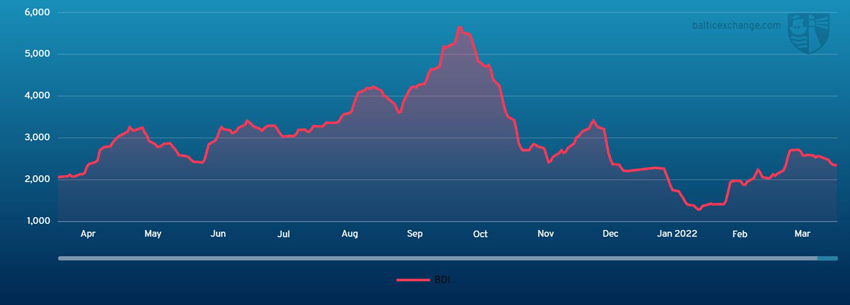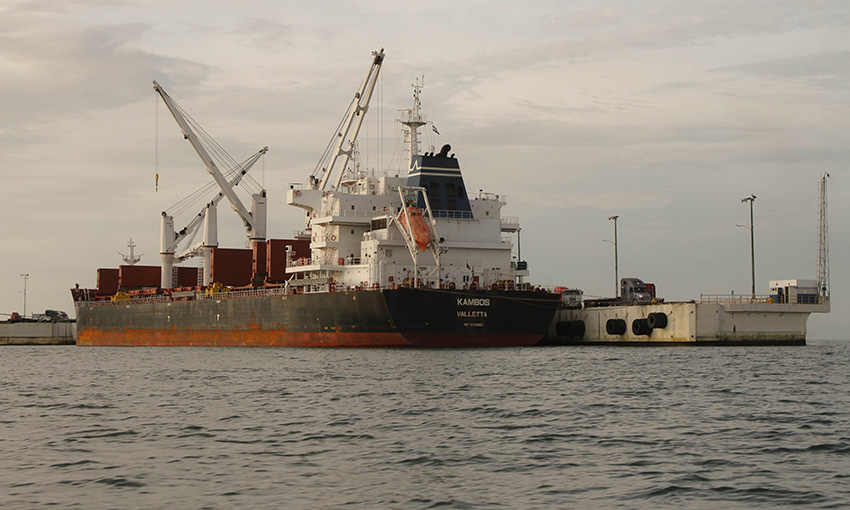LAST week, the Baltic Dry Index continued the moderate decline of the previous week. The index ended the previous week at 2544, and last week declined to 2357 by Friday 1 April, a decrease of 7% on the previous week.

Capesize
The Capesize market fared little better this week to begin with. However, by Friday green shoots were beginning to emerge as the 5TC saw a low of US$13,596, yet closed at US$15,460.
The Atlantic basin remains the Achilles’ heel of the market with poor levels of cargoes to tonnage available as the trans-Atlantic C8 settled weeks end at US$12,200.
The trans-Pacific C10 put up slightly more resistance, although activity in the region was largely underwhelming as the route closed at US$16,275.
Fuel prices continue to play a large role in the value of voyage rates with traders needing to keep a close eye on movements. In a rare occurrence, Rotterdam and Singapore bunker prices were seen to switch premium and discount positions. This is possibly very telling of the energy concerns in Europe. Voyage rates for west Australia to China C5 closed at US$10.641, while the Brazil to Tubarao C3 closed at US$26.20.
With smaller sizes still commanding a substantial premium to the Capesize sector, larger vessels are still heard to be considering the smaller cargo stems to keep activity ticking over.
Panamax
An underwhelming return for the Panamax market this week with all routes under pressure.
A distinct lack of demand in the North Atlantic aided a drift in rates. Further south there returned limited support for the longer grain trans-Atlantic rounds. Early in the week, an 81,000-dwt delivery Jorf Lasfar achieved US$32,500 via North Coast South America redelivery Skaw-Gibraltar. However, the rate was pegged back to closer to US$27,000 by Friday.
Asia disappointed too with continued pressure building. Despite a midweek surge in Indonesian coal demand, this failed to impact a market saturated by early tonnage and a lack of demand on the longer round trips. An 82,000-dwt delivery Japan agreed US$29,500 for an iron ore trip via south Australia redelivery Singapore-Japan. Meanwhile, a 79,000-dwt delivery Malaysia achieved US$27,000 for an Indonesia to China coal run. Period activity remained limited although an 82,000-dwt delivery China fixed US$32,500 for a four to six-month period.
Ultramax/Supramax
The recent strength within the Asian arena was eroded during the week as enquiry levels from key areas like Indonesia dipped, which lead to a plentiful supply of prompt tonnage.
The Atlantic was regarded by many as positional with key areas such as the US Gulf lacking fresh enquiry going forward.
Elsewhere, rates remained fairly solid from East Coast South America. However, as the week closed some brokers felt the positive sentiment was slipping. A 63,000-dwt was heard fixed delivery Recalada trip West Coast South America at US$60,000. From the US Gulf a 56,000-dwt was reported fixed for a petcoke run to Turkey at US$34,000.
Asia saw a reasonable demand for backhaul cargoes but towards the end of the week rates eased. A 63,000-dwt open Japan fixed a steels requirement to the Continent-Japan at US$37,000. Further south, a 63,000-dwt open Kendari fixed a trip via Indonesia to India at US$35,000. The BSI 10 TC weighted average finished the week at US$30.301.
Handysize
East Coast South America’s positive gains ended at a high of US$50,065, after gaining US$23,954 since 7 March, and brokers spoke of a rebalancing of tonnage to enquiry in the region. A 38,000-dwt open West Africa fixed via Brazil to the Continent with an intended cargo of pig iron at US$31,000.
Meanwhile, the Continent and Mediterranean markets remained positive. A 28,000-dwt open in the Black Sea fixed a trip to the Adriatic with redelivery passing Otranto southbound at US$21,000 with an intended cargo of coke.
In Asia, activity has been limited and sentiment much softer with big reductions on all routes. A 37,000-dwt fixed from Indonesia to China with an intended cargo of coal at high US$20,000s. A 33,000-dwt open in Japan fixed with possible waiting time to South East Asia with an intended cargo of steels at US$26,000. A 38,000-dwt open in China fixed for three to five months with worldwide redelivery at US$36,000.
Clean
The Middle East Gulf has shown mixed reactions this week and we are noticing an uptick in movement of product west. The LR2s of TC1 75k Middle East Gulf/Japan have crumbled down to a new floor of WS154.29 a round-trip TCE of US$15,783/day. The LR1s have remained resolute with TC5 55k Middle East Gulf/Japan holding in the mid 180s. A trip west on an LR1 TC8 has stayed around the US$2.85m mark. The MRs of TC17 35kt Middle East Gulf/East Africa peaked around WS290 end of last week and have dropped incrementally since, settling at the WS282.5 mark at time of writing. West of Suez, on the LR2s, TC15 80k Mediterranean/Japan remain largely untested this week and visible activity is minimal. Still US$2.7m with some activity required to prevent dropping next week
The LR1s of TC16 60k Amsterdam/Offshore Lomé were again subject to lack of demand and have dropped down through low WS140s and ended at WS137.5 level by end of week. On the UK-Continent, MRs lost steam this week, TC2 37k UK-Continent/US Atlantic Coast dipped to 192.22 (down WS8.89) and TC19 37k Amsterdam to Lagos similarly dropped 10 points, to WS 199.29. Consistent activity and high bunkers drove freight up in the US Gulf this week. As a result, TC14 38k US Gulf/UK-Continent spiked to WS213.93 (+59.29) a round-trip TCE of US$12,822 /day. The TC18 the MR US Gulf/Brazil trip also hiked up to WS259.69 (+74.33) a round trip TCE of US$21,678 /day.
The MR Atlantic basket TCE rose from US$15,440/day to US$25,713/day. TC9 has fluctuated down, then up this week after bottoming out around the WS325-330 mark. It resettled around WS350. In the Mediterranean, TC6 30kt Skikda/Lavera has continued along the floor of the WS200-205 level.
VLCC
Despite improvements being made in this sector over the course of the week, earnings are still in negative territory. 280,000mt Middle East Gulf/USG (via Cape of Good Hope) is now assessed almost two points higher than a week ago at between WS21.5/22 level. Meanwhile, on the 270,000mt Middle East Gulf/China route, rates bounced up nearly seven points to WS43.5 (a round trip TCE of minus US$8600 per day). This is after various Chinese charterers were reported on subjects in the high WS30s early in the week. Kuwaiti charterers, alongside further Chinese charterers, were then reported on subjects latterly in the low WS40s.
In the Atlantic region, the 260,000mt West Africa/China route had a fairly quiet week with only a few fixtures reported. However, on the back of the climbing Middle East market – combined with a Chinese charterer and a US Major Oil Company reported on subjects at WS45 – rates have risen seven points to be assessed at WS45 (minus US$6100 per day round-trip TCE). In the 270,000mt US Gulf/China market, although there were no reported fixtures, rates have improved by US$100,000 to US$5.51m (round voyage TCE of about minus US$7000 per day). VLCC activity in the region has been slightly more focussed on voyages from US Gulf to Europe this week where interest has spread from the rapidly improving Aframax and Suezmax sectors.
Suezmax
Rates for the 135,000mt Novorossiysk/Augusta route dropped another 5.5 points to WS177 (a round-trip TCE of US$63,400 per day) with very little reported activity. This is due in part to the continuing war in Ukraine. In the 130,000mt Nigeria/UKC market, shipowners have further capitalised on the upward momentum seen last week and rates have climbed 14 points to between WS102.5/105 level (a round-trip TCE of US$12,100 per day). This is as a result of an increased level of West African demand for tonnage, US Gulf export cargoes pulling vessels away from West Africa and a lack of ballasters from the East putting further pressure on charterers. For the 140,000mt Basra/West Mediterranean route, the rates have improved six points to just shy of WS50.
Aframax
The 80,000mt Ceyhan/Mediterranean market recovered this week, rising over 16 points to close to WS150 (a round-trip TCE of US$18,700 per day). In Northern Europe, the rate for 80,000mt Hound Point/UK Continent rose 25 points to WS153 region (a round-trip TCE of US$23,500 per day). In the 100,000mt Primorsk/UK Continent market, finding Aframax owners willing to send their ships to load in Russia for Europe discharge remains a struggle. Only three fixtures were reported this week with rates climbing from WS412.5, through WS475, and yesterday reports with limited details of WS500 being on subjects. The market is now assessed close to 155 points firmer at around the WS495/500 mark (a round voyage TCE of US$224,000 per day).
Across the Atlantic, the market continued to push on with the rate for 70,000mt East Coast Mexico/US Gulf rocketing another 60 points to slightly in excess of WS245 (a round-trip TCE of US$46,300 per day). The 70,000mt Caribbean/US Gulf trip rates were boosted 52.5 points to just below WS235 (a round-trip TCE of US$37,000 per day). In the 70,000mt US Gulf/UK Continent market, rates jumped 25 points to about WS218 (US$31,400 per day round-tip TCE, obviously improving greatly basis one-way economics).

